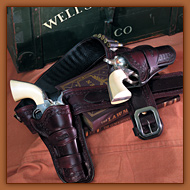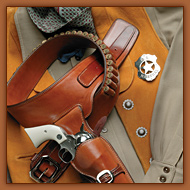
The western holster, a true and original art form, has had a long and colorful history. Its roots can be traced back to the end of the Civil War and continued through the frontier period of the American west. After the turn of the century, western lawmen, especially the Texas Rangers and U.S. Border Patrol, contributed many ideas to holster and saddle makers.
Significant improvements in western holsters occurred during the early part of the 20th century and probably peaked during the heyday of the 1940s and 50s western film and television era. Holsters took on a new meaning. They were no longer just gun "holders." Westerners wanted more substantial and stylish designs. A demand for holsters that really permitted a "Fast-Draw" arose. More thought and innovation went into holster designs, and fully leather lined belts and holsters began to appear. Holster designs that were more closely shaped to the pistol became popular and fancy stamping, carving and silver trim began to appear.

Contrary to myth and popular western film culture, "quick-draw" as we know it today simply was not possible with the holster styles of the frontier period. This historical fact in no way detracts from the courage, skill and accuracy of the old-timers. They must be judged by the conditions that existed during that time and place in history.
 Film makers of the 1930s, 40s and 50s took great liberties with holster designs worn by their heroes and outlaws. There were very few skilled holster makers during this time in Hollywood. Costume designers merely took their sketches to local saddle shops who faithfully reproduced their historically inaccurate designs.
Film makers of the 1930s, 40s and 50s took great liberties with holster designs worn by their heroes and outlaws. There were very few skilled holster makers during this time in Hollywood. Costume designers merely took their sketches to local saddle shops who faithfully reproduced their historically inaccurate designs.